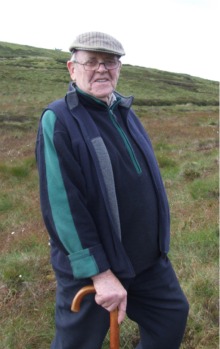|
|
Spitfire secrets uncovered in
Moneydarragh
30.06.11
by Linda McGrory
THE mangled wreckage of an iconic Spitfire plane
including its Rolls Royce engine was dug from an
Inishowen bog this week seventy years after it
crashed on neutral Irish soil during World War II.
The operation, at Glenshinney bog, Moneydarragh,
Gleneely, was the latest chapter in the story of
American pilot, Roland 'Bud' Wolfe who parachuted
from the fighter plane into a diplomatic row between
Britain and Ireland.
The 23-year old, a member of 133 'Eagle' Squadron,
was on convoy patrol when the engine overheated
eight miles from his RAF base at Eglinton - now City
of Derry Airport. Realising it would crash, he
radioed back to base with a last message, "I'm going
over the side".
He then slid back the plane's bubble canopy,
released his safety harnesses and launched himself
into the skies above a cold and foggy Inishowen
peninsula on Sunday, November 30, 1941. |
 |
|
Dig organiser and
aviation historian, Jonny McNee, holds one of the
six .303 Browning machine guns unearthed at
Glenshinney bog, Gleneely. |
The single-seat plane
soared down a steep, heather-covered valley before
plunging deep into the peat.
The one-day dig was the first licensed excavation of
a WWII aircraft in Ireland and involved some of
Britain's top aviation archaeologists. It was
organised by Northern Ireland aviation historian,
Jonny McNee, who began searching for the Spitfire
six months ago, following numerous failed attempts
by others. He said the plane was the first of 20
aircraft commissioned with £100,000 donated by
Canadian millionaire, Willard Garfield Weston,
during the Battle of Britain.
"This is the Holy Grail of Spitfires because of the
tremendous history involved in it and the fact that
it was the first Garfield Weston presentation plane.
It has 'Garfield Weston No 1' written in four-inch
yellow letters down the side of the cockpit," said
Mr McNee. He said the discovery was also prized
because of the wreckage's relatively good condition;
the story of Wolfe's two-year internment at the
Curragh detention camp and the fact he survived the
Second World War to fly in Korea and Vietnam. Wolfe
died in Florida in 1994 at the age of 76.
While the plane was "pretty smashed up", it was
remarkably well preserved in the peat, according to
English aviation archaeologist, Simon Parry. Mr
Parry’s earlier research had found that the plane
was involved in a gun battle with a German fighter
plane seven months before it crashed in Co Donegal.
"This is a very important discovery because it is
one of the very early Spitfires, made in 1941. The
pilot was lucky to survive that day because if his
engine had failed a few minutes earlier he would
have ended up in the sea."
The operation began shortly after 8am with the
plane's muddied remains beginning to emerge at 20
feet, about 11am. Among the salvage recovered by 4pm
were parts of the fuselage, six Browning .303
machine guns, two magazines, hydraulic controls, 450
bullets, a propeller, tyres, landing gear and seat
belts. A strong smell of aviation fuel clung to the
air as the dig progressed.
An Army bomb disposal unit deactivated and made safe
the machine guns and removed the munitions from the
site.
There were cheers from the large watching crowd,
when the last item, the Rolls Royce Merlin engine,
was taken from the peat shortly after 5pm. Earlier,
Wolfe’s leather flying helmet, the Spitfire logbook
and the cockpit controls, were also recovered.
Mick Harkin (88) who witnessed the drama as he was
leaving mass as an 17 year old, made his way through
knee-deep heather on Tuesday to see the dig. “The
plane was hovering about and we knew it was in
trouble but we were miles away. I saw the pilot bail
out and thought he was going to die but we heard
later he landed safe. We were all very surprised. It
was the talk of the time.”
Barney McSheffrey (83) who still cuts turf near the
site, heard the “rattle and roar” of the plane on
its descent. |
The day was also an
emotional one for the Kearney family including
siblings, Joe Dympna, Brigid and Dan. Dan’s
Falcarragh plant hire firm was appointed to excavate
the site and he had five staff on duty on the day.
Meanwhile, young locals, Conor McDermott and Conor
McLaughlin, facilitated the dig crew by ferrying
them in and out of the remote, marshy bog on quad
bikes.
The dig was filmed by Derry-based TV company 360
Productions for a BBC series on WWII military
archaeology to be broadcast next year called 'Dig
WW2'. The plane is to be preserved for future
display at the Tower Museum in Derry. Meanwhile, Mr
McNee has tracked down the pilot’s family in
America. "They are fully supportive of the project
and are making plans for a visit to Ireland in the
future to see Moneydarragh and the preserved
wreckage in the Tower Museum,” he said. |
 |
|
Barney McSheffrey, 83, heard the
'rattle and roar' of the plane before it crashed. |
"This was a historic
day on the hillside in Co Donegal. Seventy years
after the plane went in, it has now come out. We got
everything and more, more than we could ever have
expected," said an exhilarated McNee.
To view more photos click
here |
|

